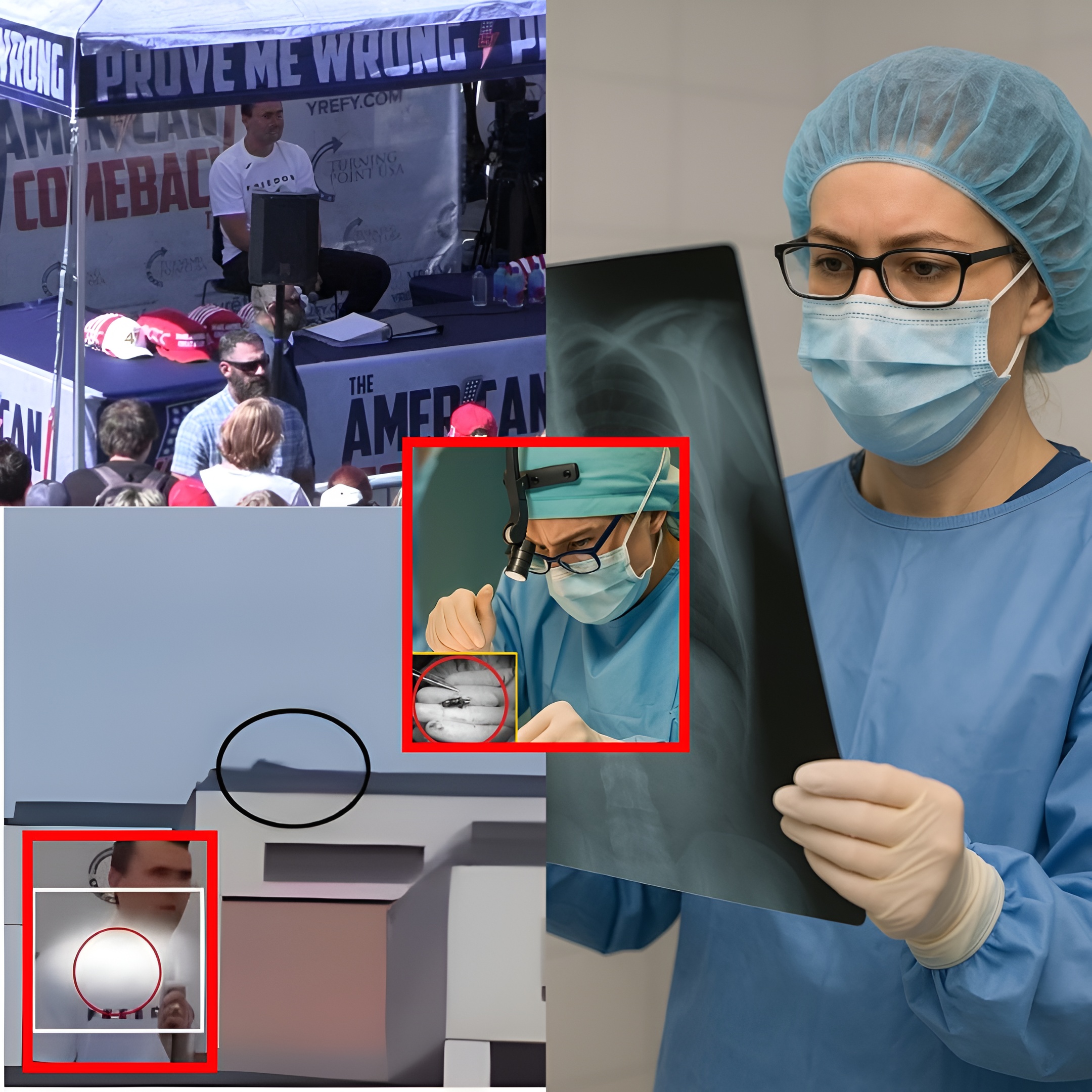When Charlie Kirk’s surgeon looked at the final X-ray, his hands began to shake. — He whispered: “That piece of metal was never supposed to stop there.”
The Night That Changed Everything
It began as an ordinary night — sterile lights, quiet monitors, and a team of specialists trained to handle the impossible. Yet nothing could have prepared them for what they would see when the final X-ray appeared on the screen.
The lead surgeon, a man known for his calm precision, paused as the image came into focus. He leaned closer, his brow tightening, his fingers frozen above the console. What appeared on the monitor defied not only medical logic but everything he had seen in two decades of surgery.
The object — a small, metallic fragment — had lodged itself in a place that no trajectory or known physical path could explain. The surgeon’s hands began to tremble.
“That piece of metal,” he whispered, “was never supposed to stop there.”
The room fell silent. The nurses exchanged glances but said nothing. For a few seconds, time itself seemed to hesitate.
No one in that room could have known that this moment — the silent disbelief of a surgeon — would later ignite one of the most puzzling medical mysteries of the year.

A Surgeon’s Silence
In the hours that followed, the team completed the operation with steady professionalism. No one spoke of what they had seen, at least not openly. But later, in his private notes, the surgeon would write a single line that stood out among the usual medical documentation:
“The image I saw tonight should not have been possible.”
When asked weeks later about the entry, the surgeon simply said, “Some things stay with you because they don’t fit in the world you know.”
He didn’t elaborate. He didn’t need to.
For those who knew him, the man’s silence spoke louder than any explanation could.
What the Image Showed
The X-ray wasn’t remarkable at first glance. It showed the expected details — tissue, bone, and the small metallic object in question. But its placement was what drew every eye.
The angle of entry, the distance traveled, and the final resting position didn’t align with the laws of motion. According to several medical consultants who reviewed the image, it appeared as though the fragment had
changed direction mid-path — something that, under standard conditions, would be impossible without external interference.
The report would later describe it as “an irregular kinetic anomaly.” But among the staff, it was known simply as
The Impossible X-ray.
Theories Begin to Form
Within days, speculation began to spread among medical circles. Some said it was a fluke — a rare but natural outcome of human anatomy and physics. Others believed it hinted at something deeper, perhaps a variable no one had yet identified.
Radiologists proposed that the fragment might have ricocheted within tissue layers in a way not yet documented. Engineers offered mathematical models that could almost explain the curve in its trajectory. Almost — but not quite.
The surgeon himself stayed quiet through it all. His focus remained on recovery and rehabilitation. But those close to him say that he never stopped thinking about the image. One colleague recalled finding him alone in the viewing room late one night, staring at the X-ray again.
“He kept zooming in and out,” the colleague said. “He wasn’t looking for an answer — he was looking for the question.”
The Human Mind vs. the Unknown
What happens when science meets something it can’t quantify? Most of the time, it adjusts. It asks new questions, refines old equations, and looks for the missing variable. But once in a while, it encounters something that simply doesn’t fit — and in that moment, the mind hesitates.
That hesitation was what haunted the surgical team. They weren’t afraid of what they had seen; they were unsettled by what they couldn’t explain.
Dr. Hannah Rios, a cognitive scientist who later analyzed the case for a research paper on “Cognitive Dissonance in High-Stress Professions,” described it this way:
“When professionals encounter anomalies, they experience an internal split between logic and instinct. Their training tells them one thing, but their senses tell them another.”
The surgeon, she noted, experienced exactly that kind of split — a moment when the rational world cracked just enough to let mystery in.

The Reconstruction
Months after the event, the team attempted to digitally reconstruct the path of the object using 3D modeling. Dozens of scans were overlaid, simulated, and tested. No matter how they adjusted the parameters, the final resting point remained unaccountable.
The modelers eventually gave up trying to explain it fully. One technician left a note on the final report: “Physics stops here.”
That phrase would become a quiet inside joke among the team — but it also captured something profound. For all the sophistication of modern science, there are still corners of the universe where explanation runs out.
Media Attention and Public Curiosity
When word of the mysterious X-ray began circulating online, it quickly caught the attention of amateur investigators, journalists, and even philosophers. But the official medical documents remained sealed, and no identifying information was ever released.
The story became less about one individual and more about the phenomenon itself — an emblem of the boundary between what we know and what we can’t yet define.
In podcasts, online forums, and late-night discussions, people began to speculate: could magnetic resonance, micro-movements, or even electromagnetic anomalies have caused such a path?
Or was it, as some suggested, just a trick of perspective — a human misreading of a complex image?
The truth remained elusive.
The Surgeon’s Confession
Nearly a year after the event, the surgeon agreed to speak privately with a team of medical researchers compiling a book about rare phenomena in clinical practice.
He didn’t want to be quoted by name, but his words were recorded:
“When you dedicate your life to understanding the body, you start to believe everything has a reason. But that night, I realized that reason doesn’t always mean explanation. Some things simply are — and that’s enough.”
He paused, then added something that later became the most quoted line from the interview:
“Sometimes, the unknown is not a flaw in our science. It’s a reminder of how small we are compared to the world we study.”
The Ethical Question
Cases like this raise more than scientific curiosity; they challenge ethical boundaries. Should unexplained findings be made public, even if they can’t be verified? Should the world know about events that defy explanation, or should they remain confined to professional study?
Bioethicist Dr. Renee Talbot argues that transparency is essential — not because the answers exist, but because the questions matter.
“We learn by acknowledging the limits of our understanding,” she said. “Every ‘impossible’ event forces us to expand the map of what might be possible tomorrow.”
The X-ray, in this sense, became not a controversy but a case study — a test of humility in the age of certainty.
The Digital Afterlife of a Mystery
In the digital age, no mystery stays private for long. Edited images, speculative threads, and viral commentary soon filled social media feeds. Some posts exaggerated the story; others tried to debunk it entirely.
Yet even in the noise, one truth remained untouched: no one could conclusively explain how that small piece of metal came to rest where it did.
Interestingly, the online debate revived interest in how modern medicine records and stores data. The X-ray became a metaphor for something bigger — the gap between human interpretation and digital reality.
In that sense, it wasn’t just a medical anomaly; it was a cultural one.
Revisiting the Science
Months later, a team at a major university attempted to replicate similar patterns under controlled lab conditions. Using ballistic gels, high-speed imaging, and advanced simulation software, they created thousands of test cases.
Only one produced a remotely similar result — and even then, it required variables that were almost impossible in a real-life scenario. The researchers concluded that while the event could theoretically happen, the odds were astronomically low.
Still, the lead scientist smiled when asked if he thought the mystery was solved.
“Solved? No. Explained, maybe. But sometimes the difference between those two words is the entire story.”
The Personal Aftermath
For the surgeon, the years that followed were quieter. He continued practicing, teaching, and writing. But every so often, colleagues noticed a certain distance in his gaze — a kind of thoughtful silence when he looked at X-rays.
“He used to say that every image tells a story,” one nurse remembered. “But after that night, I think he realized that some stories don’t end — they just stay open.”
The case changed him, but not in a way that could be measured. It reminded him — and others — that medicine is not just about precision. It’s also about wonder.
Lessons from the Unknown
The story of the “impossible X-ray” isn’t about breaking science — it’s about expanding it. Every discovery begins with disbelief. Every breakthrough starts as an anomaly that someone refuses to ignore.
That’s how progress happens. Not through certainty, but through curiosity.
As the surgeon himself once told his students:
“If everything you see makes sense, you’re not looking closely enough.”
A Modern Parable
Over time, the event became a quiet parable in medical circles — told not for its mystery, but for its meaning.
It reminded young doctors that humility is as vital as knowledge. That even the most advanced scanners can’t capture the full complexity of life.
In lectures and conferences, the story is sometimes referred to as “Case Zero” — the moment that redefined how doctors think about data, perspective, and possibility.
The Final Reflection
Today, the image still exists — archived in a secured database, rarely accessed, but never forgotten. It has become more than a medical record; it’s a symbol of the thin line between science and wonder.
When asked recently whether he still thinks about it, the surgeon smiled.
“Every time I look at an X-ray, I remember that one,” he said.
“Not because I need an answer — but because it reminds me that questions are what keep us human.”
And perhaps that’s the truest explanation of all.


